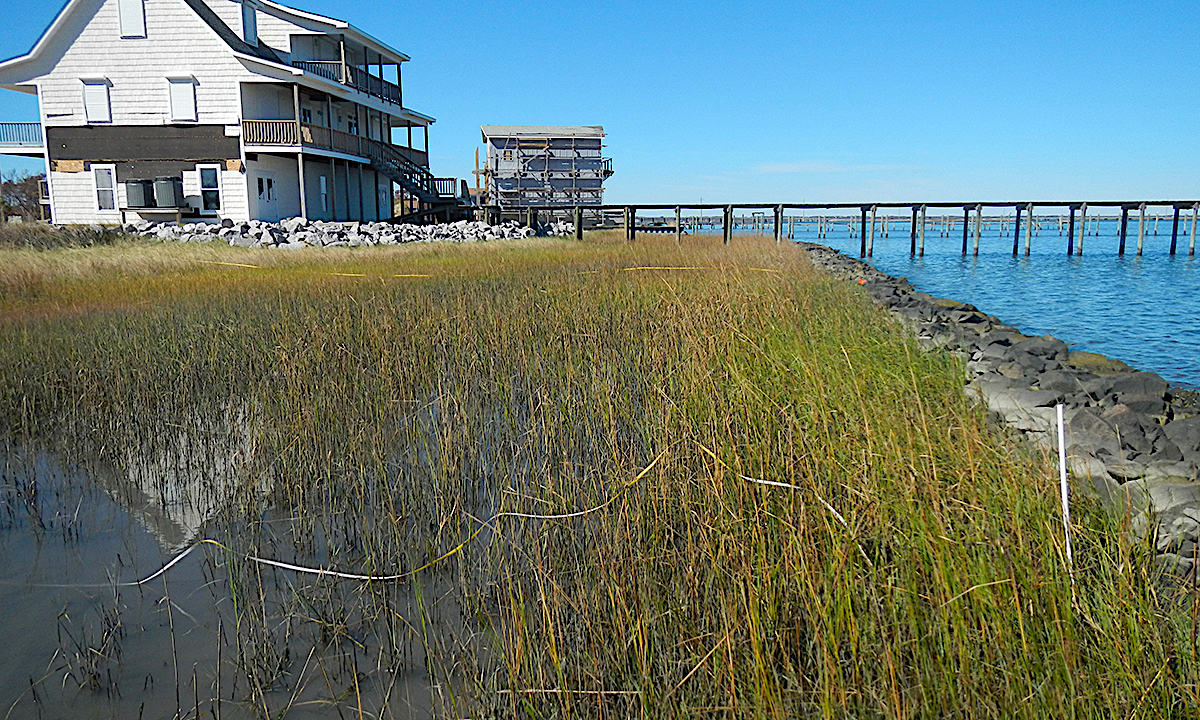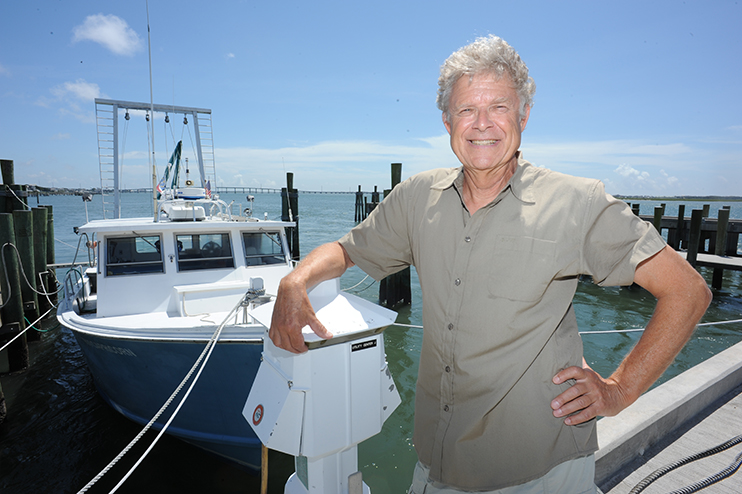Imagine waking up early on a Saturday and spending all day plucking enough grass, blade by blade, to fill several gallon-size plastic bags. Sound bizarre?
For Sue Stuska, a wildlife biologist at the Cape Lookout National Seashore, it’s a typical day in the field. For the past year, Stuska and her team of volunteers have filled dozens of plastic bags with bits of plant matter as part of a nutrients study examining the diet of the 112 wild ponies living on Shackleford Banks, a 3,000-acre uninhabited island near Atlantic Beach.
The “banker ponies” are one of only a handful of wild herds remaining in the United States. And they are thriving.
If it weren’t for a carefully detailed plan of immunocontraception, a form of birth control that uses the body’s immune response to prevent pregnancy, the horses would overwhelm the island’s food and water resources, says Stuska. The National Park Service and the Foundation for Shackleford Horses, a volunteer-based organization in Carteret County, jointly manage the herd’s birth control plan, which also ensures enough diversity remains in the gene pool.
It is the herd’s ability to thrive in spite of the harsh island conditions that motivates Stuska’s study. “We want to know how they are doing so well in an environment so different from domestic horses,” she says.
The study specifically looks at seasonal changes in the ponies’ diet, and whether different habitats provide different nutritional contents.
Stuska and her team sample 13 habitats on the island four times per year, including ocean and sand beaches, maritime forest, wet and dry grasslands, freshwater pond and marsh habitat. Samples consist of any vegetation the ponies are observed eating, as well as any bowel movements the team witnesses.
The samples are sent to labs at North Carolina State University and analyzed for protein levels, digestible energy and certain minerals. The study won’t be complete for another year, so no significant results have emerged yet. But one of the big questions researchers are examining is how the ponies’ diet compares to that of domestic horses, says Michael Yoder, an animal scientist and equine extension specialist from NC State.
“I think we are going to see that these ponies are getting by on a lot less than what we would have expected,” says Yoder.
Adult horses can eat 1.5 to 2 percent of their body weight each day, and according to conventional wisdom their diets should contain about 8 percent protein within that range, says Stuska. Breeding or lactating adults require more. But preliminary analyses of the Shackleford ponies’ forage samples found much smaller protein percentages.
“They’re definitely not getting extra protein or energy,” says Stuska. “What are they getting out there, nutritionally, that sustains them so well?”
Ponies, Not People
Stuska’s office in the Harkers Island visitor’s center is fairly typical, except for a pair of stirrups and chaps hanging on the wall, and a long felt board opposite her desk. Four sections of the board represent different areas of Shackleford Banks. Clusters of paper strips, labeled with names and numbers representing different ponies and their preferred areas on the island, adorn each section.
The ponies are given numbers for identification and research purposes, she says. “Their names are for convenience, not because they are pets.”
Stuska is adamant about keeping the ponies wild, both on the island and in public perception. She is hesitant to let publications refer to the ponies by name, lest people begin saddling them with human personality traits. That could lead visitors to try and approach or feed the ponies, and foreign foods could cause digestive problems or death. And should the ponies begin associating people with food, visitors would be at increased risk — imagine a 900-pound pony eyeballing your granola bar.
All of the study volunteers adhere to the “ponies, not pets” mindset. But no matter how objective everyone strives to be, there is no denying they are drawn to the indefinable charisma of the banker ponies.
When asked what motivated him to help study the ponies, Steve Benbow, a Morchead City insurance agent, stumbles to explain his reasoning. He uses words like “heritage,” “wildness” and “independence.”
But his sentiment is clear. These wild horses are interwoven in the culture and uniqueness of the Crystal Coast. To locals and visitors alike, the ponies are a living reminder of the area’s strong maritime ties and rugged roots.
No one is sure how wild horses came to live on Shackleford Banks, but many speculate it was some combination of early explorers, colonists, and overland trade and travel, says Stuska. One popular theory is that horses swam ashore from sinking ships in the 1400s and 1500s.
Another is that horses were left behind when settlements like Diamond City, on the eastern end of Shackleford Banks, were abandoned in the late 1800s.
Genetic samples from the Shackleford ponies reveal blood variants rarely seen in domestic horses, according to Gus Cothran, the director of the University of Kentucky’s equine blood typing research laboratory.
‘This leads us to believe that this herd of Banker Horses could be descended from a very old core group of Colonial Spanish horses,” Stuska says.
Today’s herd still reflects the survival strategies and social pecking order that kept its ancestors reproducing on Shackleford Banks for so long. The ponies organize themselves into harems, or groups of mares associated with one stallion. A stallion with a large harem has a higher status among the herd, and a greater chance of ensuring his genes are passed on to future generations.
There are about 25 harems on the island, and anywhere from five to seven “bachelor bands,” or groups of young male stallions, according to Stuska’s latest count.
“Certain harems only stay in certain areas,” explains Emily Adams, a study volunteer
and North Carolina Cooperative Extension agent. The same is true for bachelor bands, although their home ranges are slightly bigger. “They may be eating different things on different parts of the island,” she says.
Watching, Waiting
When the volunteers arrive, they are given their field kits — a GPS unit to pinpoint the location of their samples, a walkie-talkie, a soft cooler, several resealable plastic bags, and a clipboard with data sheets. They are split into groups and assigned to different areas of the island.
The groups check the ponies’ most likely haunts first, such as the freshwater ponds. The volunteers may get lucky and discover a harem or a few wandering bachelors. Or all they may find are traces of ponies — ragged edges of bushes, hoof prints or a fresh pile of dung.
When they do find ponies, volunteers approach carefully and give the animals plenty of space. The ponies may respond to this new presence with a flick of an ear or the toss of a tail, and then they turn back around.
“They just go about their business,” says Adams.
For the volunteers, the best part of the day has begun. First, they look for any numbers displayed on the ponies’ hindquarters.
These numbers are freeze-branded onto ponies during round-ups, an event to manage the herd that occurs anywhere from every two to four years. Unlike hot iron-branding, which obliterates hair follicles, freeze-branding uses a cold agent to alter follicles so that the hair grows back white.
Volunteers then cross-reference the numbers with names and document the ponies on their data sheets. Then it is time to take out the binoculars, find a comfortable patch of sand and start observing.
Sometimes there are little dramas, like tussles over the use of the watering hole. Other times, the stallions find themselves involved in bigger commotions.
“When they fight, the stallion will always send in the second-in-command first,” says Yoder. A challenge usually consists of meeting nose-to-nose, snorting and pawing the ground. During the last fight Yoder witnessed, the second-in-command began the challenge and then quickly turned and ran — the signal for the alpha stallion to take over.
“But the second-in-command immediately ran back to one of the mares that was in heat and tried to breed her while the alpha stallion was fighting. The alpha heard it and took off — he forgot all about the fight!”
Most of the time, volunteers spend the day watching the ponies eat. In the fall and winter, the brown landscape makes it difficult to see what bits of green they are consuming. Once the ponies have finished grazing, there usually isn’t much of the plant left to identify. In the late spring and summer, when the island’s vegetation is the most lush, too much green can make it difficult to decipher specific plants.
Staring through their binoculars, volunteers watch as the ponies’ lips sift through tufts of seemingly indistinguishable plants to eventually bite off something close to the ground. At first, their rummaging seems random. After a while, a certain level of meticulousness is apparent — the ponies are after specific vegetation, but what are they getting from it?
Nutritional Mystery
The main source of energy and nutrients in a horse’s diet comes from roughages, whether it is in the form of grasses or hay, Yoder explains. Research on domestic horses also shows that mineral ratios play an integral role in optimum health. If these ratios are too uneven, the body cannot use nutrients properly. Take copper and iron. Copper, along with zinc and vitamin D, is tied directly to bone development in growing animals, Yoder explains.
“If we have an extremely high percentage of iron in the diet, then that can bind copper,” he says, making the latter mineral unavailable for the body. Low levels of copper can cause abnormal tendon and ligament development, he adds.
Commercial feed companies serving North Carolina markets are aware of our iron-rich soils and supplement their products for domestic horses, says Yoder. But commercial grains are something the Shackleford ponies have never had, and will never have. And that makes researchers wonder whether the wild herd is surviving — and apparently thriving — on different mineral ratios.
“For these weanlings and yearlings on the island, you’d like to think that they’re getting enough nutrients for normal development,” Yoder says. “Apparently, they’re getting at least the bare minimum, because they seem to be getting along reasonably well.”
Study samples are analyzed for 10 to 12 different minerals, according to Yoder. In addition to copper, iron, zinc and selenium, Yoder pays special attention to calcium and phosphorous.
“We know that with [domestic] horses, we should always have two parts of calcium for every one part of phosphorous in the diet,” he says.
If the diet doesn’t provide enough calcium, the body obtains it from the bones, which can lead to brittleness and skeletal abnormalities.
“If we don’t see that [mineral ratio] in a wild situation like Shackleford Banks, that would lead us to believe the ponies are functioning just fine on different ratios,” Yoder says.
Could such ratios be why the Shackleford horses look so different than their larger, more proportional and carefully bred domestic cousins? That, in combination with their ancestor’s genetic stock, might be a small part of it, says Yoder. But there is so much about the herd and its history we will never know.
“These animals have been out here for who knows how many generations,” he says. “And what Mother Nature has created is an animal that she can sustain on this island.”
At the end of the day, when their coolers are filled with plant and dung samples, the volunteers trek back to the dock and wait for their ride home. Tomorrow, their knees and lower backs will be sore from crawling on the ground to pick at tiny pieces of grass. But a few short-term aches may lead to important long-term knowledge of this fascinating herd.
“It’s going to give us a better idea of how the ponies are surviving,” Stuska says of the study’s significance. “It will show the uniqueness of the wild horses in their adaptation to barrier island living.”
This article was published in the Early Summer 2006 issue of Coastwatch.
For contact information and reprint requests, visit ncseagrant.ncsu.edu/coastwatch/contact/.
- Categories:



